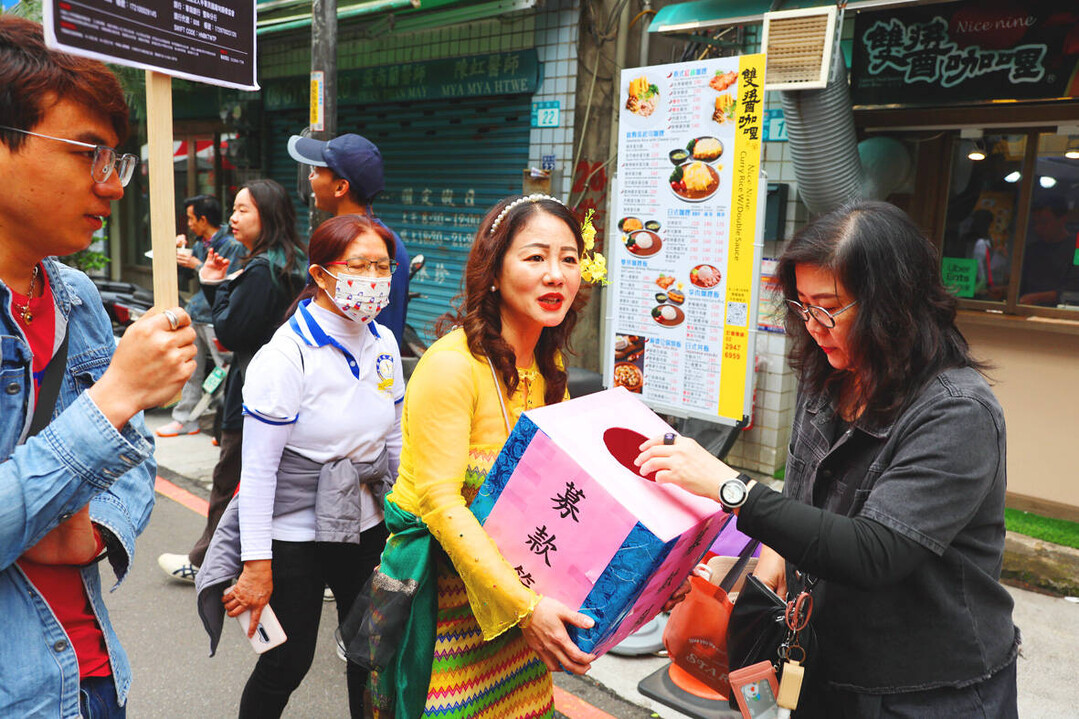
April 14, 2025, New Taipei City, Zhonghe District, Huaxin Street, also known as 'Myanmar Street,' saw the overseas Burmese Chinese community's Thingyan festival transform from its usual lively water splashing event into prayers and fundraising activities for the victims of the strong earthquake that struck Myanmar on March 28th.
At the festival site, an altar with a Buddha statue was set up, where participants continuously poured water onto the statue while offering prayers. Buddhist monks sprinkled water on festival visitors, offering blessings. This replaced the traditional water fights that had been held for many years near the Nan势角 MRT station during Thingyan, the Burmese New Year, due to the earthquake damage this year.
Instead, volunteers throughout the street held signs with QR codes, allowing people to donate to the '328 Myanmar Earthquake Joint Relief Operation,' jointly organized by the association and various local organizations. This effort aims to help the victims of the March 28th earthquake in Myanmar, which has been recorded as one of the largest earthquakes to hit Southeast Asia in the past century.
According to the New Taipei City Travel and Tourism Bureau, Southeast Asian food was provided to festival participants in Huaxin Street, home to Taiwan's largest Burmese Chinese community and numerous restaurants serving Burmese, Thai, and Yunnan (China) cuisine.
Li Pei, the chairman of the overseas Burmese Chinese community in Myanmar, stated that the traditional water splashing festival was replaced with prayers, blessing ceremonies, and a fundraising campaign to help rebuild homes for the victims of the earthquake that struck Myanmar on March 28th.
A volunteer handing out yellow ribbons to tie on trees said, "I hope there will be no more earthquakes. People are anxious because of the continuous seismic activity." Yellow ribbons symbolize mourning for disaster victims and wishing for peace and hope.
Meanwhile, according to an AP news report, Major General Zaw Min Tun, a spokesperson for the Myanmar military junta, announced that as of Friday, 3,649 people had died and 5,018 were injured due to the magnitude 7.7 earthquake that struck Myanmar on March 28th.
The earthquake was also felt in neighboring Thailand and China. In Bangkok, Thailand, a 30-story building under construction collapsed, tragically killing 32 people. The Bangkok Metropolitan Administration reported that 62 people were still missing as of Saturday.
Myanmar's Thingyan Festival and the Earthquake Disaster
The Thingyan Festival is the traditional New Year celebration in Myanmar, usually held in mid-April. This festival holds Buddhist significance and is famous for its lively water splashing, symbolizing the washing away of negativity from the past year and welcoming the new year. It is an important cultural event that signifies community harmony and prosperity, holding great meaning for the people of Myanmar.
The magnitude 7.7 earthquake that struck Myanmar on March 28th was one of the strongest earthquakes in 100 years, causing extensive damage. Along with a large number of casualties, there was severe destruction of homes and infrastructure, resulting in a large number of displaced people in need of urgent relief and support.
The decision by the overseas Burmese Chinese community in Myanmar is seen as a demonstration of solidarity to help their suffering neighbors instead of holding their traditional festival. Their efforts to convey warm condolences and provide practical help to the people of Myanmar facing difficulties due to the disaster are noteworthy. The funds raised through this campaign will be valuable in supporting the recovery of the earthquake-stricken areas and assisting the displaced residents.
[Copyright (c) Global Economic Times. All Rights Reserved.]






























